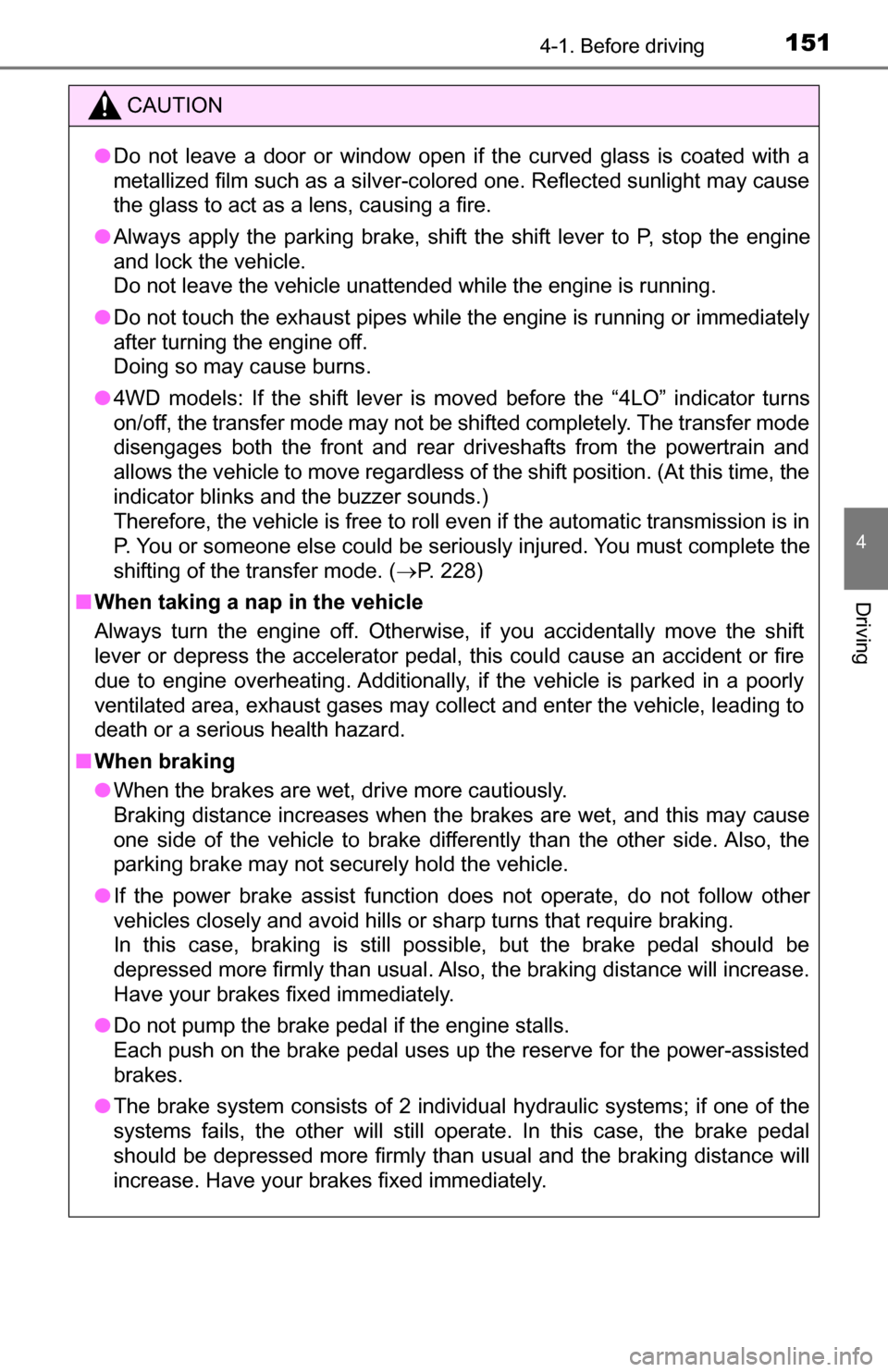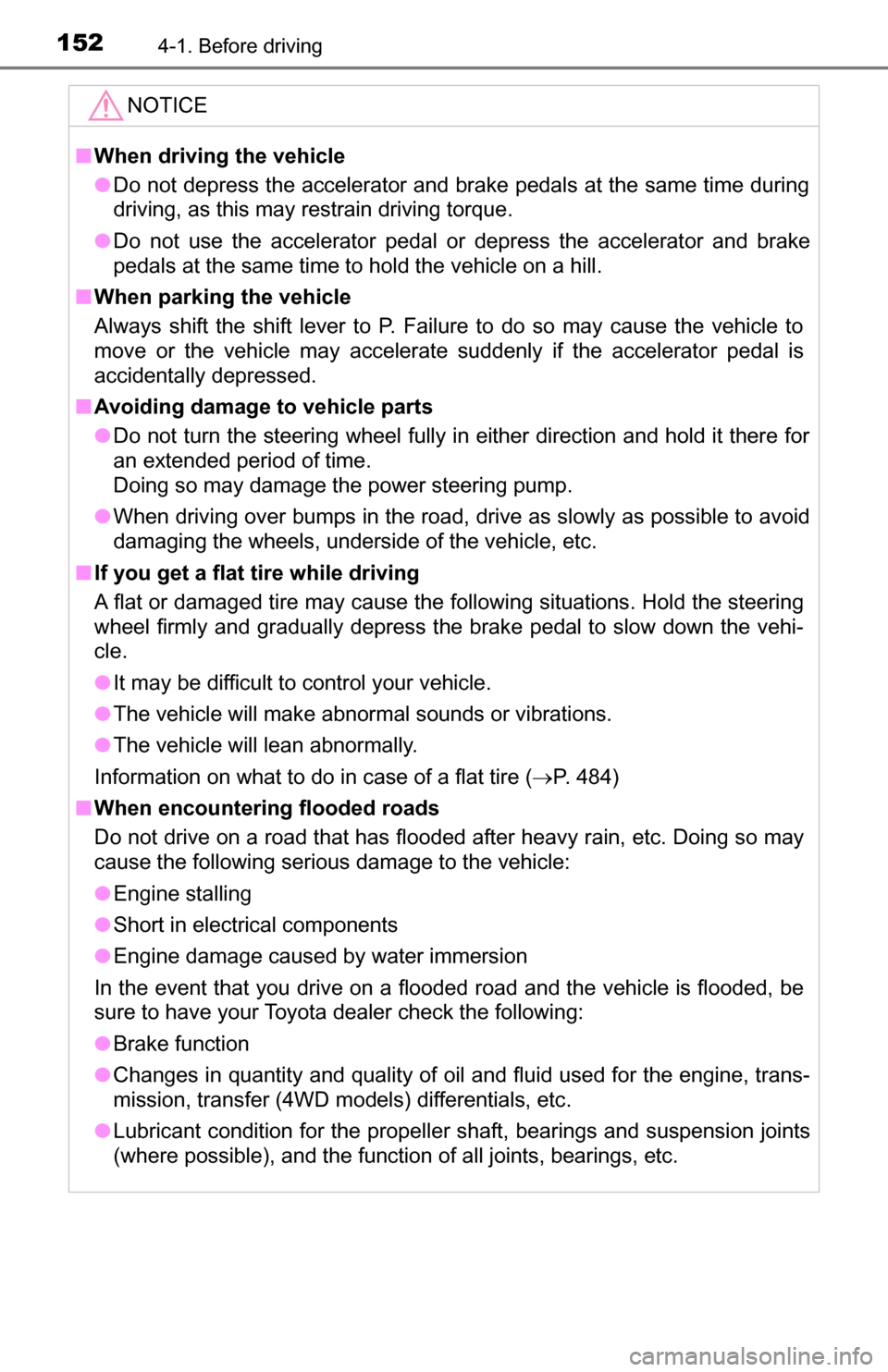Page 86 of 588
862. Instrument cluster
The indicators inform the driver of the operating state of the vehicle’s
various systems.
Indicators
Turn signal indicator
( P. 189)*3, 4
(If equipped)
BSM outside rear view
mirror indicator
(P. 220)
(U.S.A.)
Headlight indicator
(P. 191) Security indicator
(
P. 78, 80)
(Canada)
Tail light indicator
(P. 191)*1
“AUTO LSD” indicator
(P. 231, 234)
Headlight high beam
indicator ( P. 192)
*1, 5
“AIR BAG ON” and
“AIR BAG OFF”
indicators ( P. 50)
*6
Cruise control indicator
(P. 202)
Cruise control “SET”
indicator ( P. 202)
(4WD models)
“4HI” indicator ( P. 228)
*1, 2
Slip indicator
(P. 232, 234)
(4WD models)
“4LO” indicator ( P. 228)
*1
VSC off indicator
(P. 231, 234, 236, 237)
*6
(If equipped)
Trailer connection indica-
tor ( P. 240)
“TOW HAUL” indicator
( P. 187)
Page 151 of 588

1514-1. Before driving
4
Driving
CAUTION
●Do not leave a door or window open if the curved glass is coated with a
metallized film such as a silver-colored one. Reflected sunlight may cause
the glass to act as a lens, causing a fire.
● Always apply the parking brake, shift the shift lever to P, stop the engine
and lock the vehicle.
Do not leave the vehicle unattended while the engine is running.
● Do not touch the exhaust pipes while the engine is running or immediately
after turning the engine off.
Doing so may cause burns.
● 4WD models: If the shift lever is moved before the “4LO” indicator turns
on/off, the transfer mode may not be shifted completely. The transfer mode
disengages both the front and rear driveshafts from the powertrain and
allows the vehicle to move regardless of the shift position. (At this time, the
indicator blinks and the buzzer sounds.)
Therefore, the vehicle is free to roll even if the automatic transmission is in
P. You or someone else could be seriously injured. You must complete the
shifting of the transfer mode. ( P. 228)
■ When taking a nap in the vehicle
Always turn the engine off. Otherwise, if you accidentally move the shift
lever or depress the accelerator pedal, this could cause an accident or fire
due to engine overheating. Additionally, if the vehicle is parked in a poorly
ventilated area, exhaust gases may collect and enter the vehicle, leading to
death or a serious health hazard.
■ When braking
● When the brakes are wet, drive more cautiously.
Braking distance increases when the brakes are wet, and this may cause
one side of the vehicle to brake differently than the other side. Also, the
parking brake may not securely hold the vehicle.
● If the power brake assist function does not operate, do not follow other
vehicles closely and avoid hills or sharp turns that require braking.
In this case, braking is still possible, but the brake pedal should be
depressed more firmly than usual. Also, the braking distance will increase.
Have your brakes fixed immediately.
● Do not pump the brake pedal if the engine stalls.
Each push on the brake pedal uses up the reserve for the power-assisted
brakes.
● The brake system consists of 2 individual hydraulic systems; if one of the
systems fails, the other will still operate. In this case, the brake pedal
should be depressed more firmly than usual and the braking distance will
increase. Have your brakes fixed immediately.
Page 152 of 588

1524-1. Before driving
NOTICE
■When driving the vehicle
● Do not depress the accelerator and brake pedals at the same time during
driving, as this may restrain driving torque.
● Do not use the accelerator pedal or depress the accelerator and brake
pedals at the same time to hold the vehicle on a hill.
■ When parking the vehicle
Always shift the shift lever to P. Failure to do so may cause the vehicle to
move or the vehicle may accelerate suddenly if the accelerator pedal is
accidentally depressed.
■ Avoiding damage to vehicle parts
● Do not turn the steering wheel fully in either direction and hold it there for
an extended period of time.
Doing so may damage the power steering pump.
● When driving over bumps in the road, drive as slowly as possible to avoid
damaging the wheels, underside of the vehicle, etc.
■ If you get a flat tire while driving
A flat or damaged tire may cause the following situations. Hold the steering
wheel firmly and gradually depress the brake pedal to slow down the vehi-
cle.
● It may be difficult to control your vehicle.
● The vehicle will make abnormal sounds or vibrations.
● The vehicle will lean abnormally.
Information on what to do in case of a flat tire ( P. 484)
■ When encounterin g flooded roads
Do not drive on a road that has flooded after heavy rain, etc. Doing so may
cause the following serious damage to the vehicle:
● Engine stalling
● Short in electrical components
● Engine damage caused by water immersion
In the event that you drive on a flooded road and the vehicle is flooded, be
sure to have your Toyota dealer check the following:
● Brake function
● Changes in quantity and quality of oil and fluid used for the engine, trans-
mission, transfer (4WD models) differentials, etc.
● Lubricant condition for the propeller shaft, bearings and suspension joints
(where possible), and the function of all joints, bearings, etc.
Page 162 of 588
1624-1. Before driving
Confirm that the gross trailer weight, gross combination weight, gross
vehicle weight, gross axle weight and tongue weight are all within the
limits.
■GCWR*5 and TWR*5
Regular Cab models
GCWR, TWR, Unbraked TWR, Fifth wheel and Gooseneck towing
TWR
Model code*1EngineDriving
systemBed typeGCWRTWR
USK51L-THTSKA 3UR-FE
engine
2WD
Long14000 lb.
(6350 kg)
*28500 lb.
(3855 kg)
*2
16000 lb.
(7258 kg)
*310500 lb.
(4760 kg)
*3
16000 lb.
(7258 kg)
*410400 lb.
(4715 kg)
*4
USK51L-THTSGA 3UR-FBE
engine 14000 lb.
(6350 kg)
*28500 lb.
(3855 kg)
*2
16000 lb.
(7258 kg)
*310500 lb.
(4760 kg)
*3
16000 lb.
(7258 kg)
*410400 lb.
(4715 kg)
*4
USK56L-THTSKA 3UR-FE
engine 4WD 14000 lb.
(6350 kg)
*28300 lb.
(3765 kg)
*2
16000 lb.
(7258 kg)
*310200 lb.
(4625 kg)
*3
16000 lb.
(7258 kg)
*410100 lb.
(4580 kg)
*4
Page 163 of 588
1634-1. Before driving
4
Driving
*1: The model code is indicated on the Certification Label. (P. 519)
*2: Vehicles without towing package
*3: Vehicles with towing package
*4: Vehicles with towing package and large fuel tank
USK56L-THTSGA
3UR-FBE
engine 4WD Long 14000 lb.
(6350 kg)
*28300 lb.
(3765 kg)
*2
16000 lb.
(7258 kg)
*310200 lb.
(4625 kg)
*3
16000 lb.
(7258 kg)
*410100 lb.
(4580 kg)
*4
*5: These models meet the tow-vehicle trailering requirement of SAE
International per SAE J2807.
Model code*1EngineDriving
systemBed typeGCWRTWR
Page 164 of 588
1644-1. Before driving
Double Cab models
Model code*1EngineDriving
systemBed typeGCWRTWR
UPK51L-CRTSKA 1UR-FE
engine 2WD
Standard 12500 lb.
(5670 kg) 6800 lb.
(3080 kg)
UPK56L-CRTSKA 4WD 12500 lb.
(5670 kg) 6500 lb.
(2945 kg)
USK51L-CRTSKA 3UR-FE engine
2WD 14000 lb.
(6350 kg)
*28300 lb.
(3765 kg)
*2
16000 lb.
(7258 kg)
*310300 lb.
(4670 kg)
*3
16000 lb.
(7258 kg)
*410200 lb.
(4625 kg)
*4
USK51L-CRTLKA 14000 lb.
(6350 kg)
*28300 lb.
(3765 kg)
*2
16000 lb.
(7258 kg)
*310200 lb.
(4625 kg)
*3
16000 lb.
(7258 kg)
*410100 lb.
(4580 kg)
*4
USK51L-CRTSGA
3UR-FBE engine 14000 lb.
(6350 kg)
*28300 lb.
(3765 kg)
*2
16000 lb.
(7258 kg)
*310300 lb.
(4670 kg)
*3
16000 lb.
(7258 kg)
*410200 lb.
(4625 kg)
*4
USK51L-CRTLGA 14000 lb.
(6350 kg)
*28300 lb.
(3765 kg)
*2
16000 lb.
(7258 kg)
*310200 lb.
(4625 kg)
*3
16000 lb.
(7258 kg)
*410100 lb.
(4580 kg)
*4
Page 165 of 588
1654-1. Before driving
4
Driving
USK52L-CHTSKA3UR-FE
engine
2WD Long 14000 lb.
(6350 kg)
*28100 lb.
(3670 kg)
*2
16000 lb.
(7258 kg)
*310100 lb.
(4580 kg)
*3
16000 lb.
(7258 kg)
*410000 lb.
(4535 kg)
*4
USK52L-CHTSGA 3UR-FBE
engine 14000 lb.
(6350 kg)
*28100 lb.
(3670 kg)
*2
16000 lb.
(7258 kg)
*310100 lb.
(4580 kg)
*3
16000 lb.
(7258 kg)
*410000 lb.
(4535 kg)
*4
USK56L-CRTSKA
3UR-FE engine 4WDStandard 14000 lb.
(6350 kg)
*28000 lb.
(3625 kg)
*2
16000 lb.
(7258 kg)
*310000 lb.
(4535 kg)
*3
16000 lb.
(7258 kg)
*49800 lb.
(4445 kg)
*4
USK56L-CRTLKA 14000 lb.
(6350 kg)
*27900 lb.
(3580 kg)
*2
16000 lb.
(7258 kg)
*39900 lb.
(4490 kg)
*3
15700 lb.
(7122 kg)
*49500 lb.
(4305 kg)
*4
USK57L-CHTSKA Long14000 lb.
(6350 kg)
*27900 lb.
(3580 kg)
*2
16000 lb.
(7258 kg)
*39800 lb.
(4445 kg)
*3
15930 lb.
(7226 kg)
*49700 lb.
(4400 kg)
*4
Model code*1EngineDriving
systemBed typeGCWRTWR
Page 166 of 588
1664-1. Before driving
*1: The model code is indicated on the Certification Label. (P. 519)
*2: Vehicles without towing package
*3: Vehicles with towing package
*4: Vehicles with towing package and large fuel tank
USK56L-CRTSGA
3UR-FBE engine 4WDStandard 14000 lb.
(6350 kg)
*28000 lb.
(3625 kg)
*2
16000 lb.
(7258 kg)
*310000 lb.
(4535 kg)
*3
16000 lb.
(7258 kg)
*49800 lb.
(4445 kg)
*4
USK56L-CRTLGA 14000 lb.
(6350 kg)
*27900 lb.
(3580 kg)
*2
16000 lb.
(7258 kg)
*39900 lb.
(4490 kg)
*3
15700 lb.
(7122 kg)
*49500 lb.
(4305 kg)
*4
USK57L-CHTSGA Long14000 lb.
(6350 kg)
*27900 lb.
(3580 kg)
*2
16000 lb.
(7258 kg)
*39800 lb.
(4445 kg)
*3
15930 lb.
(7226 kg)
*49700 lb.
(4400 kg)
*4
Model code*1EngineDriving
systemBed typeGCWRTWR